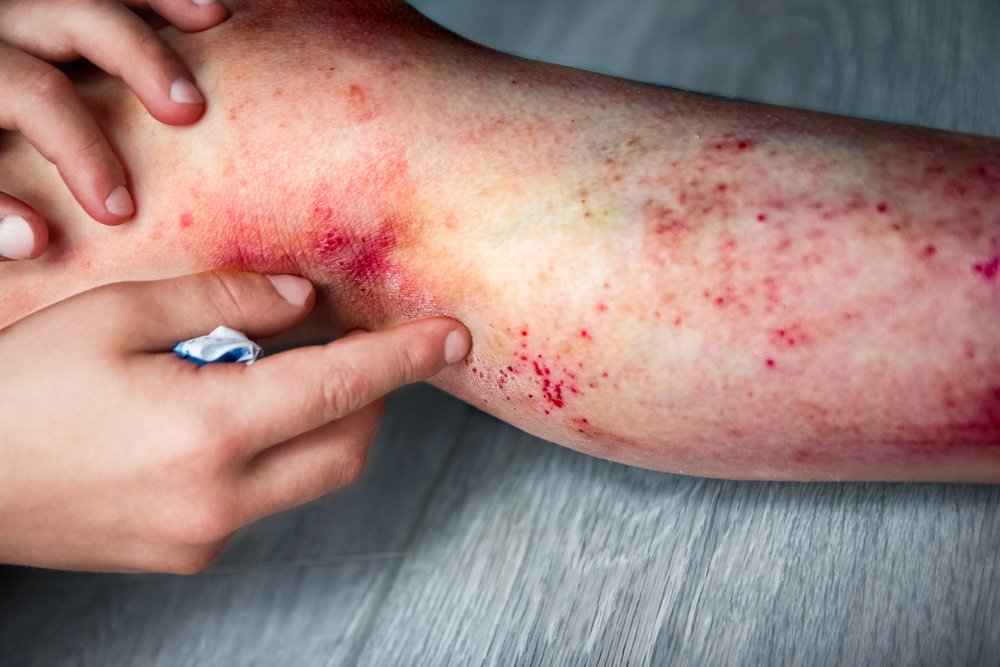Learn
Delve into dermatology diseases with new approaches from conventional to complementary care.
Topics
Explore a broad spectrum of dermatological conditions and topics to enhance your practice.
Training Programs
Expert led instruction for every level of patient care.
Log in to see enrolled program content.
Conferences
Gain practical insights and meet new colleagues.
Hover over a conference to view recordings.
Join Us
The largest integrative dermatology community.
Various Approaches To Treat Staph Infections in Eczema
Controlling the skin microbiome in eczema

Atopic dermatitis (eczema) is a chronic inflammatory skin condition. Eczema mostly affects children but some adults suffer from the condition as well. People with eczema suffer from severely itchy skin that results in inflamed, red, and rough patches of skin mostly on the inner side of the elbows and behind the knees. Eczema is likely caused by a dysfunctional skin barrier combined with inflammation in the skin.[1]
It has been known for a while now that the skin of people with eczema is more likely to develop an infection. Normally, our skin cells and immune system work together very well to prevent skin infections. However, in people with eczema, some of these defensive abilities of the body become dysfunctional. This immune dysfunction of the skin in people with eczema leads to higher levels of bacteria compared to normal adults.[2]
Staph Infections are Common in Eczema
Although we are all covered (colonized) with bacteria, these bacteria rarely lead to actual disease (i.e. infections). This is not the case in people with eczema who often develop skin infections with a particular bacteria called Staphylococcus aureus (S. aureus). When S. aureus leads to infected eczema, the typical result is red skin patches that have a yellowish-golden crust on top of them. Studies have demonstrated that when compared to normal skin, people with eczema are colonized with S. aureus to a much greater extent.[1,3] Combining the facts that skin afflicted with eczema has an impaired barrier function and dysfunctional immunity with the higher numbers of S. aureus on the skin, it is not surprising that there is a higher frequency of eczema S. aureus infections.
Additionally, recent research suggests that the high presence of S. aureus on the skin of people with eczema may “drive” the disease by inducing more inflammation.[4] The incidence of the more dangerous methicillin-resistant S. aureus (known as MRSA) is on the rise and is a cause for alarm for people with eczema.[4] MRSA can turn a standard skin infection into a serious and potentially life-threatening condition because MRSA is resistant to many antibiotic medications.
The Use of Antibiotics for Infected Eczema Treatments
Considering all of the above it should be clear that doctors are very concerned about S. aureus infections in patients with eczema. When patients with eczema come to see their doctors and have S. aureus-infected skin, treatment with antibiotics is often initiated.[5]
Over the years it has become clear that repeatedly using antibiotics to treat skin infections in people with eczema is not a viable long-term solution and can have dangerous consequences.
- First, the infections may come back once the antibiotics are completed
- Second, the liberal use of antibiotics can lead to drug-resistant bacterial infections, such as MRSA infections
- Third, the frequent use of antibiotics may have consequences as they significantly change the composition of the human microbiome (good bacteria) possibly leading to an environment that is more likely to welcome more dangerous (virulent) bacteria[4]
In order to overcome this issue doctors and scientists have developed other strategies to prevent S. aureus infection in people with eczema.
Non-antibiotic Approaches to Controlling Eczema
Bleach Baths
Prevention is usually the best approach, as it tends to be more effective and less expensive. To date, the best-studied approach to preventing skin infections in eczema is the use of dilute bleach bath combined with the application of mupirocin (topical antibiotic medication) to the insides of the nose.[6] Interestingly this approach not only helps to reduce the numbers of bacteria on the skin, but it also helped to improve the eczema rash. Importantly, bleach baths do not lead to antibiotic resistance and, if used appropriately, do not lead to irritation or decreased skin barrier function.[5-7]
Silver Impregnated Underwear
The use of silver impregnated underwear has been promoted recently but there is little evidence available to assess its utility in people with eczema.[5]
Probiotics
The use of topical probiotics seems to make sense in eczema: adding more “good bacteria” is safe and will help to restore the bacterial balance in the body. However, there are few studies available and not enough evidence to say whether this is helpful or not at this time.[5]
New and Emerging Therapies
Looking to the future, newer approaches are being studied to fight S. aureus skin infections. These approaches use antibodies to selectively attack parts of S. aureus that help it infect the skin.[4] This approach will avoid the development of antibacterial resistance but is predicted to be expensive. Other approaches that are currently under investigation include the use of cationic steroids and adenovirus to help the skin cells make more antimicrobial peptides. Antimicrobial peptides are protein molecules that can kill bacteria and are known to be decreased in the skin of people with eczema.[4]
References
- Bieber T. Atopic dermatitis. N Engl J Med.2008;358(14):1483-1494; PMID: 18385500 Link to research.
- Matiz C, Tom WL, Eichenfield LF, et al. Children with atopic dermatitis appear less likely to be infected with community acquired methicillin-resistant Staphylococcus aureus: the San Diego experience. Pediatr Dermatol.2011;28(1):6-11; PMID: 21070347 Link to research.
- Kong HH, Oh J, Deming C, et al. Temporal shifts in the skin microbiome associated with disease flares and treatment in children with atopic dermatitis. Genome Res.2012;22(5):850-859; PMID: 22310478 Link to research.
- Hepburn L, Hijnen DJ, Sellman BR, et al. The complex biology and contribution of Staphylococcus aureus in atopic dermatitis, current and future therapies. Br J Dermatol.2016;10.1111/bjd.15139PMID: 27779765 Link to research.
- Eichenfield LF, Tom WL, Berger TG, et al. Guidelines of care for the management of atopic dermatitis: section 2. Management and treatment of atopic dermatitis with topical therapies. J Am Acad Dermatol.2014;71(1):116-132; PMID: 24813302 Link to research.
- Huang JT, Abrams M, Tlougan B, et al. Treatment of Staphylococcus aureus colonization in atopic dermatitis decreases disease severity. Pediatrics.2009;123(5):e808-814; PMID: 19403473 Link to research.
- Shi VY, Foolad N, Ornelas JN, et al. Comparing the effect of bleach and water baths on skin barrier function in atopic dermatitis: a split-body randomized controlled trial. Br J Dermatol.2016;175(1):212-214; PMID: 26875771 Link to research.
Related Articles

Atopic Dermatitis
Atopic Dermatitis Case Discussion with Dr. Peter Lio

Atopic Dermatitis
Navigating the Complexities of Atopic Dermatitis and Prurigo Nodularis: A Clinical Toolkit for Practitioners

Atopic Dermatitis
Navigating Atopic Dermatitis and Hand & Foot Dermatitis




